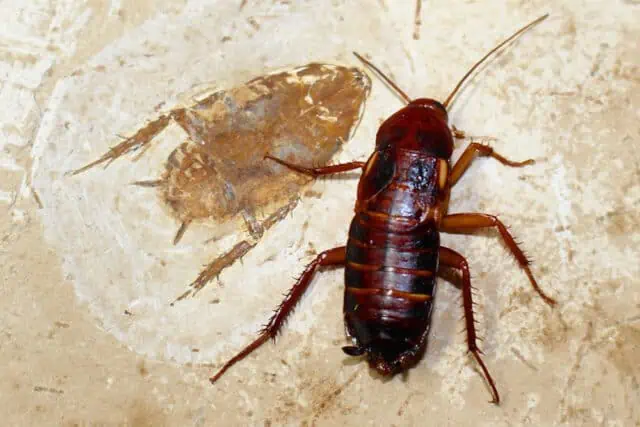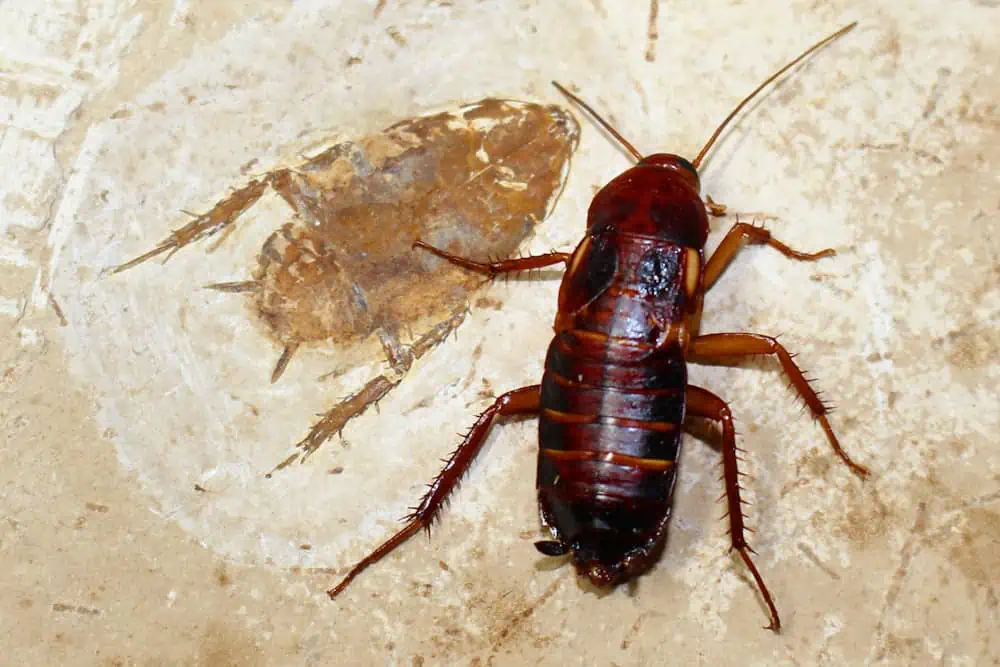Yes, leopard geckos can eat cockroaches. Cockroaches can serve as a nutritious treat for these reptiles, providing them with essential nutrients. However, just like any other treat, it’s important to know which type of cockroaches are suitable and how they should be prepared to ensure the health and safety of your pet.
Can Leopard Geckos Eat Cockroaches?
Indeed, leopard geckos can and do eat cockroaches. While these insects might not be a favorite snack for many of us, for leopard geckos, they are a welcome addition to their diet.
Cockroaches offer a different nutritional profile than other insects, making them a valuable source of variety. But before you start tossing roaches into your gecko’s habitat, it’s essential to understand the specifics, like which types of cockroaches are best and how they should be fed to your gecko.
What are Cockroaches?
Cockroaches are a group of insects that have been around for millions of years, coexisting with various species, including leopard geckos in their natural habitats.
In the wild, leopard geckos often come across these insects, making them a part of their natural diet. While there are numerous species of cockroaches, not all are suitable for leopard geckos to consume.
The size of the cockroach matters: geckos can safely eat those that are about the size of the space between their eyes. Feeding cockroaches that are too large might pose choking risks.
Moreover, while cockroaches can be a nutritious meal, there are potential risks involved, especially if the source of the cockroaches isn’t known or trusted.
Benefits of Feeding Cockroaches to Leopard Geckos
There are numerous advantages to incorporating cockroaches into the diet of your leopard gecko. Firstly, cockroaches are rich in essential nutrients, offering a good mix of proteins, fats, and minerals that contribute to a balanced diet.
Unlike some fatty treats, cockroaches provide these nutrients without causing undue weight gain, ensuring that your gecko stays in top shape.
Risks of Feeding Cockroaches to Leopard Geckos
While cockroaches can be a beneficial addition to a leopard gecko’s diet, it’s crucial to be aware of potential health risks and challenges. One of the primary concerns is that a steady diet of cockroaches can lead to addiction. Leopard geckos might develop a preference for these insects, refusing other foods. This can be detrimental, as a diverse diet is necessary to provide all the nutrients a gecko needs for optimum health.
Additionally, not all cockroaches are created equal. Feeding your gecko wild-caught cockroaches from unreliable sources might expose them to pesticides or other harmful chemicals. Furthermore, if the cockroach size isn’t appropriate for your gecko’s size, it might lead to choking hazards or digestive issues.
There’s also a risk of overfeeding, which can cause obesity and related health issues. It’s imperative to monitor the quantity and frequency of cockroach feedings.
To minimize these risks, it’s crucial to choose safe types of cockroaches, preferably those bred for pet consumption. These are typically raised in controlled environments without exposure to chemicals and are of a suitable size for leopard geckos.
Safe Types of Cockroaches for Leopard Geckos

When it comes to feeding your leopard gecko, it’s essential to provide them with the safest types of cockroaches. The most recommended species for leopard geckos include Dubia roaches, Red Runner roaches (also known as Turkestan roaches), and Discoid roaches. These species are not only nutritious but are also of an appropriate size, making them ideal for geckos.
The origin and environment in which these cockroaches are raised play a pivotal role in determining their safety. Cockroaches bred in a controlled environment, away from pesticides and contaminants, are the healthiest choices for leopard geckos. Conversely, roaches from backyards or kitchens might carry harmful chemicals or parasites, posing risks to your pet.
To ensure you’re getting the best quality cockroaches for your gecko, it’s advisable to purchase from reputable sources.
Preparing Cockroaches for Your Leopard Gecko
Ensuring that the cockroaches you feed your leopard gecko are well-prepared is vital not just for the pet’s enjoyment, but also for its health. Proper preparation goes beyond just selecting the right type of roach; it involves cleaning, possible de-winging, and introducing them to the gecko in a way that stimulates its natural hunting instincts.
Cleaning and De-Winging the Cockroach
Before presenting a cockroach to your leopard gecko, it’s essential to ensure it’s clean and safe to consume. Begin by gently rinsing the cockroach under lukewarm water to remove any dirt or debris. This simple cleaning step is crucial to eliminate potential contaminants that might harm your gecko.
While many leopard geckos can consume cockroaches with wings, de-winging is a recommended step, especially for smaller or younger geckos. By removing the wings, you reduce the risk of choking hazards or potential injuries caused by sharp or rough wing edges.
Maintaining a clean environment for your gecko is equally important. Smooth surfaces in their habitat prevent dirt accumulation and make cleaning more straightforward.
Feeding the Prepared Cockroach to Your Leopard Gecko
Feeding your leopard gecko might seem straightforward, but ensuring it’s done correctly can make a significant difference in your pet’s health and happiness. Begin by selecting a cockroach that’s appropriately sized for your gecko. Once you’ve chosen the right cockroach, start the preparation process. As discussed earlier, cleaning and de-winging are vital steps. Gently rinse the roach to remove any dirt and, if necessary, carefully remove its wings for the safety of smaller geckos.
After preparing the cockroach, it’s time to introduce it to your gecko’s enclosure. Here are the steps to ensure a smooth feeding process:
- Place the cockroach in a feeding dish: This step can prevent the roach from hiding in the enclosure, making it easier for the gecko to spot its meal.
- Position the dish close to the gecko: This action piques their interest and triggers their natural hunting instincts.
- Observe the gecko’s response: Some geckos might pounce immediately, while others may take a moment to approach.
- Ensure safety: Always monitor the feeding to ensure the gecko consumes the roach without any issues.
How Much Should You Feed?
Feeding your leopard gecko the right amount is just as crucial as ensuring they get a nutritious diet. Overfeeding or underfeeding can lead to various health issues and discomfort for your pet. The ideal quantity depends on several factors, including the gecko’s age, size, and overall health.
Amounts Per Day/Week/Month
The feeding regimen for your leopard gecko should be tailored to its specific age and size requirements.
For baby leopard geckos, which are still growing rapidly, it’s recommended to feed them 5-7 small roaches daily until they attain a body length of about four inches.
As they transition into the juvenile phase, they can consume larger roaches on a daily basis.
When your gecko reaches adulthood, their metabolism slows down slightly, and their feeding schedule should be adjusted accordingly.
Adult geckos thrive when fed every other day, basing the quantity on their size: typically, two roaches for every inch of their body length.
Amounts Based on Size of Your Gecko
When it comes to feeding leopard geckos, size genuinely matters. Different gecko sizes demand unique dietary requirements.
Juvenile geckos, still in their growing phase, have a higher metabolism and, as such, require a consistent supply of food. However, as they transition into adulthood, their dietary needs shift.
Overfeeding, regardless of the gecko’s age, can pose significant health risks such as obesity and associated complications. It’s crucial to adhere to guidelines for size-based feeding to maintain the health of the gecko.
For instance, while a juvenile might eat daily, an adult gecko’s portion would be more substantial but less frequent. By considering the size of your gecko, you can provide the appropriate food amount, ensuring optimal health and growth.
Nutrients in Different Types of Roaches
Roaches, beyond their infamous reputation, are nutrient powerhouses, especially for leopard geckos. Different types of roaches carry distinct nutritional values beneficial for geckos.
Dubia roaches, for instance, stand out among feeder insects due to their higher protein and calcium content, making them a preferable alternative to crickets or grasshoppers. Their softer exoskeleton also ensures easier digestibility.
Animals such as tarantulas, bearded dragons, and certain types of amphibians also include roaches in their diet. For gecko owners, breeding roaches can be a cost-effective approach to secure a steady, nutritious diet for their pets.





